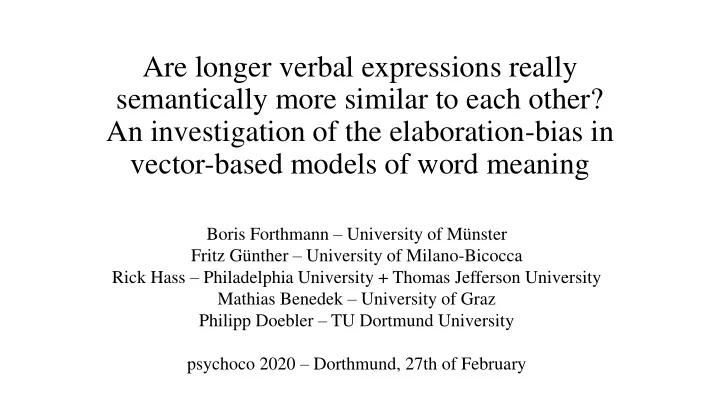

Are longer verbal expressions really semantically more similar to each other? An investigation of the elaboration-bias in vector-based models of word meaning Boris Forthmann – University of Münster Fritz Günther – University of Milano-Bicocca Rick Hass – Philadelphia University + Thomas Jefferson University Mathias Benedek – University of Graz Philipp Doebler – TU Dortmund University psychoco 2020 – Dorthmund, 27th of February
Divergent thinking „The unique feature of divergent production is that a variety of responses is produced “ (Guilford, 1959)
Divergent thinking Is an indicator of … • Everyday creative thinking ability (Kaufman & Beghetto, 2009) • Creative potential (Lubart, Besançon, & Barbot, 2011; Runco & Acar, 2012)
Creative process (Mumford et al., 2008) 1. Problem definition 2. Information gathering 3. Concept selection 4. Conceptual combination 5. Idea generation → divergent thinking 6. Idea evaluation 7. Implementation 8. Monitoring
The Alternate Uses Task • Instruction: Please name as many different uses for a knife as possible. Idea Person 1 2 3 4 as a wheapon 1 1 1 1 as a dart 0 1 1 0 as a screwdriver 1 0 1 0 as a cake server 0 0 0 1 stirring coffee 1 0 0 1 Reiter-Palmon, R., Forthmann, B., & Barbot, B. (2019). Scoring divergent thinking tests: A review and systematic framework. Psychology of Aesthetics, Creativity, and the Arts , 13 (2), 144-152.
Fluency Scoring Idea Person 1 2 3 4 as a wheapon 1 1 1 1 as a dart 0 1 1 0 as a screwdriver 1 0 1 0 as a cake server 0 0 0 1 stirring coffee 1 0 0 1 Fluency-Score 3 2 3 3
Uniqueness Scoring (Originality) Idea Person 1 2 3 4 as a wheapon 1 1 1 1 as a dart 0 1 1 0 as a screwdriver 1 0 1 0 as a cake server 0 0 0 1 stirring coffee 1 0 0 1 Uniqueness-Score 0 0 0 1 Uniqueness-Ratio 0 0 0 0.33 Forthmann, B., Paek, S. H., Dumas, D., Barbot, B., & Holling, H. (2019). Scrutinizing the basis of originality in divergent thinking tests: On the measurement precision of response propensity estimates. British Journal of Educational Psychology . Advance online publication.
Creative Quality Scores • Originality (Wilson, Guilford, Christensen, 1953) • Uncommonness • Cleverness • Remoteness • Appropriateness
Creative Quality Scores • Originality (Wilson, Guilford, Christensen, 1953) • Uncommonness • Cleverness • Remoteness → semantic distance → vector-based models of word meaning • Appropriateness
Vector-based models of word meaning – I • All models represent word meanings as high-dimensional numerical vectors (i.e., semantic space) • These models allow computing of the semantic similarity between any pair of words (or larger expressions) as cosine similarity between their respective vectors • These models predict a variety of human behavior: • Categorization tasks • Synonym tests • Similarity judgments • Lexical priming
Vector-based models of word meaning – II • Latent Semantic Analysis (LSA; Landauer & Dumais, 1997) • Word-by-document co-occurrences • Weighting schemes (e.g., pointwise mutual information) • Dimensionality reduction (e.g., singular value decomposition) • Hyperspace Analogue to Language model (HAL; Lund & Burgess, 1996) • Based on word-by-word co-occurrences • Weighting schemes and dimensionality reduction (analogous to LSA) • Continuous Bag of Words model (CBOW as part of word2vec; see Mikolov et al., 2013)
Vector-based models of word meaning – III • Continuous Bag of Words model (CBOW as part of word2vec; see Mikolov et al., 2013) • Based on a neural network architecture • Target words are predicted by sorrounding words
Why Using Vector-based Models of Word Meaning? 1. Scoring is objective 2. The models are empirically validated 3. The models are theoretically justified 4. Scoring is less labor intensive as compared to other scorings 5. There are freely available tools to apply the models
Study 1 – Forthmann et al. (2017) Participants: N = 199 (female = 142; age: M = 24.48, SD = 6.86) DT tasks: Alternate Uses (rope, garbage bag, paperclip); 2.5 minutes; be-creative instructions Scoring: Overall quality (Ratings) Cleverness (Ratings) Uncommonness (Statistical Frequency) Semantic Distance (LSA) Complexity/Elaboration (number of characters) Forthmann, B., Holling, H., Çelik, P., Storme, M., & Lubart, T. (2017). Typing speed as a confounding variable and the measurement of quality in divergent thinking. Creativity Research Journal , 29 (3), 257-269.
Results – Study 1 – Forthmann et al. (2017) Forthmann, B., Holling, H., Çelik, P., Storme, M., & Lubart, T. (2017). Typing speed as a confounding variable and the measurement of quality in divergent thinking. Creativity Research Journal , 29 (3), 257-269.
Study 2 – Simulation Results (LSA semantic distance) – Forthmann et al. (2019) Forthmann, B., Oyebade, O., Ojo, A., Günther, F., & Holling, H. (2019). Application of latent semantic analysis to divergent thinking is biased by elaboration. The Journal of Creative Behavior , 53 (4), 559-575.
Open Questions • Does the elaboration bias generalize to other vector- based models of word meaning? • How does the bias emerge? • Are computationally less intensive bias-corrections available as compared to a simulation-based correction (Forthmann et al., 2019)?
Generalization check
How does the bias emerge? • The bias occurs when at least one of the column means of the semantic space is different from zero
How can we mitigate the bias without simulations? • Centering of ranked columns • Inverse normal transformation of the columns • Transformations applied only to the first component • Transformations combined with postmultiplication of the column standard deviations
Do these transformations work? • For English spaces 9 → In 8 cases out of the benchmarks were 12 benchmark checks checked (1 synonym, 5 HAL with inverse rating, 3 normal transformation categorization) yielded the best • For German spaces 3 performance benchmarks were checked (2 rating, 1 categorization)
Questions? Discussion points?
Thank you for your interest!
Recommend
More recommend